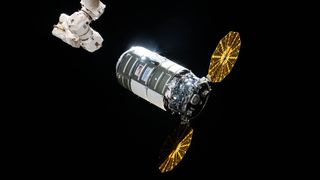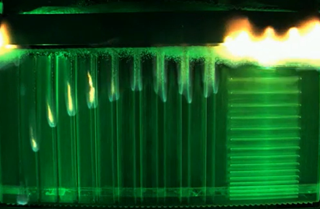Fire-safety experiment among science gear launching to International Space Station this weekend
It's part of a set of investigations that could improve batteries, tumor treatments and more.

A Cygnus cargo ship launching toward the International Space Station (ISS) this weekend will carry an experiment designed to improve fire safety on moon and Mars missions.
Called SoFIE (Solid Fuel Ignition and Extinction), the experiment is the latest in a series of in-orbit investigations that look at how fire behaves in microgravity. SoFIE is part of a larger haul of science, supplies and hardware flying on Northrop Grumman's Cygnus NG-17 resupply mission, which is scheduled to launch at 12:39 p.m. EST (1739 GMT) on Saturday (Feb. 19).
"What we hope to do is inform future missions on material flammability as they work prototype designs for future spacesuits, cabins and habitats and predict how those materials would burn in lunar, Martian or other environments," Paul Ferkul, SoFIE project scientist at NASA's Glenn Research Center in Ohio, told Space.com via e-mail.
"The experiments also will help NASA identify the best ways to put out fires or smoldering materials in space," Ferkul added.
The Cygnus launch will take place from the Mid-Atlantic Regional Spaceport at NASA’s Wallops Flight Facility on Wallops Island, Virginia. Coverage will be carried on NASA Television, the NASA app, NASA social media and also here at Space.com. Note that the timing of the launch may change for technical, weather or other reasons.
Video: Watch astronauts capture Cygnus NG-16 in orbit
When SoFIE reaches the ISS, the experiment will be installed in the Combustion Investigation Rack, located on the U.S. Laboratory Module (Destiny) for safe combustion research.
Get the Space.com Newsletter
Breaking space news, the latest updates on rocket launches, skywatching events and more!
"The space station provides a unique microgravity environment that enables scientists to study the true nature of flames isolated and unaltered by gravity," Ferkul said.
Moreover, livestreamed video along with sensor data will allow the team at Glenn to look at flames while they are burning, and even make adjustments for ignition factors, flow speed, oxygen, pressure and radiant heating.
The tests will involve samples that are between about 4 inches and 12 inches (10 and 30 centimeters) long. The experiment will look at plexiglass, cotton-based fabrics and other materials commonly used in spaceflight, Ferkul said. It's scheduled to run until November 2025.
Ferkul said the science history of this experiment draws upon work previously performed by two other NASA experiments: the Flame Extinguishment Experiment (FLEX) and the Advanced Combustion via Microgravity Experiments (ACME).
FLEX, which is now concluded, focused on "the effectiveness of inert-gas suppressants in microgravity and obtain[ing] the most conservative estimate of the limiting oxygen index for steady combustion," its experiment webpage states.
ACME has a secondary focus on fire safety in space, along with a primary goal to improve the efficiency of combustion technology and reduce its pollution emissions, according to its webpage. In January, a flame design experiment used chamber pressure differences in an attempt to alter flame size and saw changes instead in brightness.
Cygnus freighters are also known for hosting a series of fire safety experiments during the deorbiting process, which are collectively known as Spacecraft Fire Safety (Saffire). Controllers deliberately light a fire inside the spacecraft, which is already en route to a planned destruction in Earth's atmosphere, to investigate large-scale flame growth and material flammability. Aside from the focus on fire safety, however, Saffire and SoFIE have little in common, Ferkul said.

"The Saffire experiments used large samples — up to nearly 100 cm [40 inches] in length — which were possible because there was no crew present," Ferkul said.
"Unlike SoFIE, the five Saffire tests were performed autonomously, burning fuel samples in a pre-determined series of steps," he continued. "Because of communication limitations, video could only be downloaded after the tests were complete, which made any real-time changes or adjustments — such as flow speed — impossible."
Ferkul was unavailable during a NASA phone-in press conference last Thursday (Feb. 10) that discussed a selection of other science experiments on Cygnus, their goals and their possible benefits for a range of science and engineering applications. The experiments highlighted were:
- Colgate Skin Aging experiment, led by Colgate. It "evaluates cellular and molecular changes in engineered human skin cells in microgravity," according to a NASA press release. Changes in such cells have implications for matters such as fighting off infection or regulating body temperature, which are some of the functions of skin.
- MicroQuin 3D Tumor , led by MicroQuin. It "examines the effects of a drug on breast and prostate cancer cells in space," NASA says. Microgravity encourages these cells to grow in three dimensions, which allows investigators a chance to scrutinize the structure.
- OGA H2 Sensor Demo (OGS) , led by NASA's Marshall Space Flight Center in Alabama. This experiment "tests new sensors for the space station’s oxygen generation system." OGS separates hydrogen from oxygen through electrolysis. While current sensors ensure no hydrogen comes into the cabin, they are sensitive to factors like moisture and require swapping out every 201 days.
- Space As-Lib, an experiment from the Japanese Aerospace Exploration Agency examining "a lithium-ion secondary battery capable of safe, stable operation under extreme temperatures and in a vacuum environment." The battery has flame-retardant materials and does not leak liquid, among other attributes.
- eXposed Root On-Orbit Test System (XROOTS) investigation, led by the spaceflight company Sierra Nevada Corp. This experiment tests plant growth in hydroponic (water-based) and aeroponic (air-based) systems, instead of using soil. If successful, these systems could reduce the mass of plant experiments.
Cygnus NG-17 will bring up hardware for about 40 investigations for NASA, the U.S. National Laboratories and international partners, Jennifer Buchli, deputy chief scientist for the International Space Station program at NASA's Johnson Space Center in Houston, said during the press conference.
The spacecraft will haul nearly 2,000 pounds (roughly 900 kilograms) of science technology demonstrations and utilization to space, with an expected 248 hours of research time for the crew, Buckley added. The ISS program seeks to prioritize crew time for science, although astronauts also spend time on matters such as space station maintenance, as well as exercise and personal hygiene.
"NG-17 kicks off a very busy and exciting spring," Buckley said. "In just four months, we'll have two cargo resupply missions carrying experiments and facilities that will continue that orbiting laboratory's contribution to improving life on Earth and pushing us farther into deep space."
Forthcoming crewed highlights that Buckley cited include the first all-private space mission to the ISS, Axiom Space's Ax-1; SpaceX's Crew 4 launch to the orbiting lab; and the return of NASA astronaut Mark Vande Hei after nearly a year-long mission in space.
Boeing's long-delayed uncrewed Orbital Flight Test 2 is also expected to launch in the late spring, to assess the Starliner spacecraft's readiness to carry astronauts.
Follow Elizabeth Howell on Twitter @howellspace. Follow us on Twitter @Spacedotcom or Facebook.
Join our Space Forums to keep talking space on the latest missions, night sky and more! And if you have a news tip, correction or comment, let us know at: community@space.com.

Elizabeth Howell (she/her), Ph.D., is a staff writer in the spaceflight channel since 2022 covering diversity, education and gaming as well. She was contributing writer for Space.com for 10 years before joining full-time. Elizabeth's reporting includes multiple exclusives with the White House and Office of the Vice-President of the United States, an exclusive conversation with aspiring space tourist (and NSYNC bassist) Lance Bass, speaking several times with the International Space Station, witnessing five human spaceflight launches on two continents, flying parabolic, working inside a spacesuit, and participating in a simulated Mars mission. Her latest book, "Why Am I Taller?", is co-written with astronaut Dave Williams. Elizabeth holds a Ph.D. and M.Sc. in Space Studies from the University of North Dakota, a Bachelor of Journalism from Canada's Carleton University and a Bachelor of History from Canada's Athabasca University. Elizabeth is also a post-secondary instructor in communications and science at several institutions since 2015; her experience includes developing and teaching an astronomy course at Canada's Algonquin College (with Indigenous content as well) to more than 1,000 students since 2020. Elizabeth first got interested in space after watching the movie Apollo 13 in 1996, and still wants to be an astronaut someday. Mastodon: https://qoto.org/@howellspace
